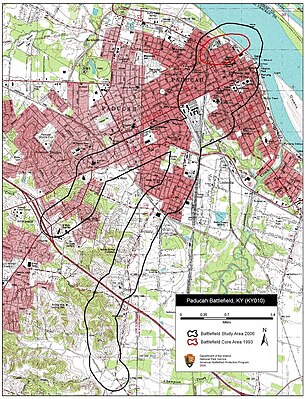| Battle of Paducah | |||||||
|---|---|---|---|---|---|---|---|
| Part of the American Civil War | |||||||
| |||||||
| Belligerents | |||||||
|
|
| ||||||
| Commanders and leaders | |||||||
|
Stephen G. Hicks James Shirk | Nathan Bedford Forrest | ||||||
| Units involved | |||||||
| Forrest's Cavalry Department | ||||||
| Strength | |||||||
|
650 men 2 gunboats | 3,000 | ||||||
| Casualties and losses | |||||||
| 90 | 50 | ||||||
| Forrest's Expedition into West Tennessee and Kentucky | |
|---|---|
The Battle of Paducah was fought on March 25, 1864, during the American Civil War. A Confederate cavalry force led by Maj. Gen. Nathan Bedford Forrest moved into Tennessee and Kentucky to capture Union supplies. Tennessee had been occupied by Union troops since 1862. He launched a successful raid on Paducah, Kentucky, on the Ohio River.
Events

In March 1864, Forrest set out from Columbus, Mississippi, for raiding in West Tennessee and Kentucky, with a force of just under 3,000 men. His object was to recruit soldiers, re-equip his men with supplies, and disrupt Union activities. He reached Paducah on March 25 and quickly occupied the town. The Union garrison of 650 men under Col. Stephen G. Hicks withdrew to Fort Anderson, in the town's west end. The fort was supported by two Union gunboats on the Ohio River, and Hicks began shelling the area with his artillery.
Forrest tried to bluff Hicks into surrendering, warning him, "... if I have to storm your works, you may expect no quarter." Knowing the fort could not be easily taken, Hicks rejected the demand.
With the Union garrison holed up in their fort, Forrest's men began loading any Union Army supplies they could use into wagons and destroyed the rest. They rounded up all the army horses and mules they could find. A portion of Forrest's men from Kentucky decided to attack Fort Anderson on their own, much to his irritation. This attack constituted the Battle of Paducah. It was repulsed, causing the Confederates heavy and needless casualties. In reporting on the raid, many newspapers stated that Forrest missed more than a hundred fine horses hidden by the Yankees. As a result, Forrest sent Colonel Abraham Buford back to Paducah in mid-April and he captured these horses.
Casualties during the Paducah raid totaled 90 Union soldiers and 50 Confederates, most of them during the attack on the fort. The raid was counted as a victory for the Confederates because they had fewer casualties and gained some supplies, but they achieved little beyond destroying Union supplies and capturing needed cavalry mounts. They did not take the fort or alter control of the region. The raid put the Union Army on notice that Forrest and other Confederates raiders could still strike deep into Union-held territory.
See also
References
- ^ United States. War Dept; Henry Martyn Lazelle; Leslie J. Perry (1891). The War of the Rebellion: v.1-53 [serial no. 1-111] Formal reports, both ... Washington: Government Printing Office. p. 547.
External links
- "Battle of Paducah", National Park Service description
- Update to the Civil War Sites Advisory Commission: Report on the Nation's Civil War Battlefields /Commonwealth of Kentucky, National Park Service, Washington, DC: October 2008
| Kentucky in the American Civil War | |
|---|---|
| Origins | |
| Combatants | |
| Campaigns | |
| Battles | |
| Involvement (by city or town) | |
| Aftermath |
|
| Related topics | |
| See also: Timeline of Kentucky in the American Civil War | |
37°05′35″N 88°36′21″W / 37.0931°N 88.6058°W / 37.0931; -88.6058
Categories:- Battles of the American Civil War in Kentucky
- Forrest's Expedition into West Tennessee and Kentucky
- Battles of the Western Theater of the American Civil War
- Confederate victories of the American Civil War
- Raids of the American Civil War
- McCracken County, Kentucky
- 1864 in Kentucky
- Conflicts in 1864
- March 1864 events